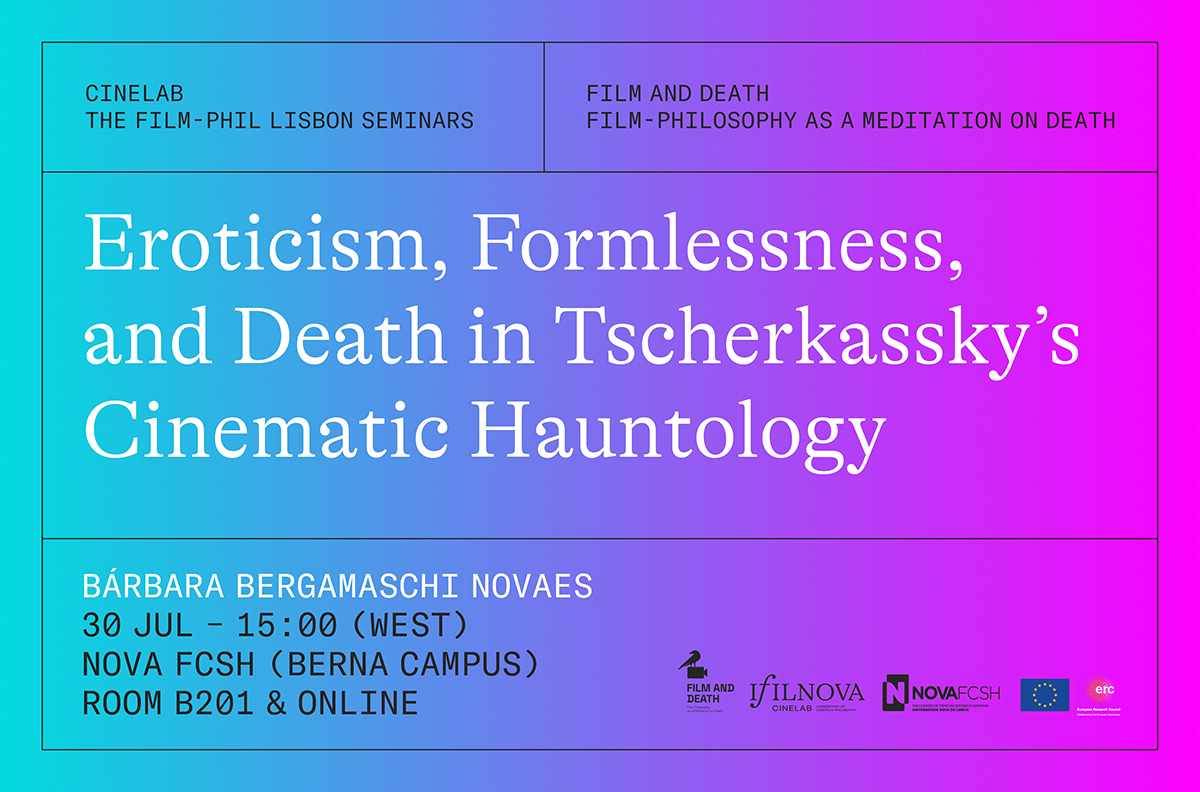The Film-Phil Lisbon Seminars: Bárbara Bergamaschi Novaes

The next Film-Phil Lisbon Seminar will be led by Bárbara Bergamaschi Novaes (ICNOVA) who will talk about “Eroticism, Formlessness, and Death in Tscherkassky’s Cinematic Hauntology”. The session will be held on July 30, 2025, at 15:00 WEST in room B201 of NOVA FCSH (Av. de Berna, 26 C) and online via Microsoft Teams. To receive information about joining the meeting online, it’s mandatory to register in advance here.
Abstract
This paper examines the work of Austrian avant-garde filmmaker Peter Tscherkassky through the lens of Georges Bataille’s concepts of l’informe (the formless), eroticism, and expenditure. Positioned within the poetics of obsolescence and the broader hauntological turn in contemporary experimental cinema, Tscherkassky reappropriates archival material notto reconstruct a lost cinematic past, but to perform a kind of aesthetic vivisection. His films operate in the ruins of the medium, embracing crisis, decay, glitch, and spectrality as central aesthetic strategies.
Drawing on Thomas Elsaesser’s idea of “cinema of obsolescence” and Mark Fisher’s hauntology — where memory returns as technological residue — Tscherkassky’s work can be seen as a form of necropoetic cinema: a practice that resists the necropolitics of late capitalism through a sensual engagement with media death. The poetics of obsolescence embodies a passionate attachment to “dead” media — degraded, decaying, or contaminated — infusing the notion of cinephilia with new meaning. Rather than preserving or restoring filmic heritage to its pristine form, he enacts what Georges Didi-Huberman terms a “heuristics of anachronism”.
Films such as Outer Space (1999) and Instructions for a Light and Sound Machine (2005) exemplify this approach. By destabilizing cinematic classical form and narrative teleology, Tscherkassky revives Bataille’s radical aesthetics — particularly the embrace of excess, rupture, and the transgression of classical mimesis. In this way, his cinema stages a confrontation with the medium’s material limits and historical canonical ghosts.
In an inflection with Bataille’s excessive, anti-axiomatic thought, much of Tscherkassky’s oeuvre is parricidal in nature — a violent gesture toward cinematic forebears that paradoxically honors them. Repeatedly slaying the ghosts of the canon, he radically denies (while simultaneously resurrecting) the traditional narrative structures from which his work descends. He is, in this regard, an iconoclast par excellence.
Ultimately, Tscherkassky’s cinema does not seek a return to a melancholic restorative golden age of cinema, but instead proposes a necromantic cinephilia: a love for damaged images and spectral presence that foregrounds the cinematic language itself. His films propose a genealogical attempt to re-enchant images long since pacified by narrative teleology and the regime of representation of aristotelian poetics. His anachronistic and extemporaneous cinema articulates both a response to, and a symptom of, the crisis of contemporary cinematic experience — an encounter with cinematic language at its very limit.
Bio
Bárbara Bergamaschi Novaes, Brasília, 1989. She holds a PhD in Literature from PUC-Rio (Pontifical Catholic University of Rio de Janeiro), with a doctoral exchange period at the CITAR – School of Arts of the Portuguese Catholic University in Porto. Her doctoral thesis focused on the cinema of Peter Tscherkassky. In 2012, she studied film at Université Paris VIII. Bárbara is a film critic affiliated with ABRACCINE/FIPRESCI (The International Federation of Film Critics). She has published articles in several specialized outlets, including Revista Aniki, La Furia Umana, Doc-Online, Significação, Revista Cinética, O Estado de São Paulo, and the Cinema Blog of the Moreira Salles Institute, among others. She is currently the Science Communication Manager at ICNOVA and a visiting lecturer in the Department of Communication at NOVA University Lisbon, where she resides.

